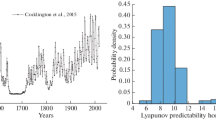Abstract
We analyze the yearly mean sunspot-number data covering the period 1700 to 2012. We show that the yearly sunspot number is a low-dimensional deterministic chaotic system. We perform future predictions trying to forecast the solar activity during the next five years (2013 – 2017). We provide evidence that the yearly sunspot-number data can be used for long-term predictions. To test and prove that our model is able to predict the Maunder Minimum period (1645 – 1715), we perform long-term post-facto predictions comparing them with the observed sunspot-number values. We also perform long-term future predictions trying to forecast the solar activity up to 2102. Our predictions indicate that the present Cycle 24 is expected to be a low-peak cycle. We conclude that the level of solar activity is likely to be reduced significantly during the next 90 years, somewhat resembling the Maunder Minimum period.














Similar content being viewed by others
References
Ahluwalia, H.S.: 2003, Meandering path to solar activity forecast for Cycle 23. In: Velli, M., Bruno, R., Malara, F. (eds.) AIP Conf. Proc. CP679, Pisa, Italy, 176. DOI .
Badalyan, O.G., Obridko, V.N., Sykora, J.: 2001, Brightness of the coronal green line and prediction for activity cycles 23 and 24. Solar Phys. 199, 421. DOI .
Clilverd, M.A., Clarke, E., Rishbeth, H., Clark, T.D.G., Ulich, T.: 2003, Solar activity levels in 2100. Astron. Geophys. 44, 5.20. DOI .
de Jager, C., Usoskin, I.: 2006, On possible drivers of Sun-induced climate changes. J. Atmos. Solar-Terr. Phys. 68, 2053. DOI .
de Meyer, F.: 2003, A transfer function model for the sunspot cycle. Solar Phys. 217, 349. DOI .
Eddy, J.A.: 1976, The Maunder Minimum. Science 192, 1189. DOI .
Fraser, A.M., Swinney, H.L.: 1986, Independent coordinates for strange attractors from mutual information. Phys. Rev. A 33, 1134. DOI .
Faria, H.H., Echer, E., Rigozo, R., Vieira, L.E.A., Nordemann, D.J.R., Prestes, A.: 2004, A comparison of the spectral characteristics of the Wolf sunspot number and group sunspot number. Solar Phys. 223, 305. DOI .
Friis-Christensen, E., Lassen, K.: 1991, Length of the solar cycle: an indicator of solar activity closely associated with climate. Science 254, 698. DOI .
Gkana, A., Zachilas, L.: 2015, Sunspot numbers: data analysis, predictions and economic impacts. J. Eng. Sci. Technol. Rev. 8, 79. www.jestr.org/downloads/Volume8Issue1/fulltext148115.pdf .
Grassberger, P., Procaccia, I.: 1983a, Characterization of strange attractors. Phys. Rev. Lett. 50, 346. DOI .
Grassberger, P., Procaccia, I.: 1983b, Measuring the strangeness of strange attractors. Physica D 9, 189. DOI .
Hoyt, D.V., Schatten, K.H.: 1992, A new look at Wolf sunspot numbers in the late 1700’s. Solar Phys. 138, 387. DOI .
Hoyt, D.V., Schatten, K.H.: 1998, Group sunspot numbers: a new solar activity reconstruction. Solar Phys. 179, 189. DOI .
Kantz, H.: 1994, A robust method to estimate the maximal Lyapunov exponent of a time series. Phys. Lett. A 185, 77. DOI .
Kennel, M.B., Brown, R., Abarbanel, H.D.I.: 1992, Determining embedding dimension for phase-space reconstruction using a geometrical construction. Phys. Rev. A 45, 3403. DOI .
Lean, J.L., Rind, D.H.: 2008, How natural and anthropogenic influences alter global and regional surface temperatures: 1889 to 2006. Geophys. Res. Lett. 35, L18701. DOI .
Mann, M.E., Zhang, Z., Rutherford, S., Bradley, R.S., Hughes, M.K., Shindell, D., et al.: 2009, Global signatures and dynamical origins of the little ice age and medieval climate anomaly. Science 326, 1256. DOI .
Maunder, E.W.: 1922, The prolonged sunspot minimum 1675 – 1715. J. Br. Astron. Assoc. 32, 140.
Muscheler, R., Beer, J., Kubik, P.W.: 2004, Long-term solar variability and climate change based on radionuclide data from ice cores. In: Pap, J.M., Fox, P., Frohlich, C., Hudson, H.S., Kuhn, J., McCormack, J., et al. (eds.) Solar Variability and Its Effects on Climate, Washington, D.C. DOI .
Pesnell, W.D.: 2012, Solar cycle predictions (Invited review). Solar Phys. 281, 507. DOI .
Reid, G.C.: 1987, Influence of solar variability on global sea surface temperatures. Nature 329, 142. DOI .
Rigozo, N.R., Nordemann, D.J.R., Echer, E., Echer, M.P.S., Silva, H.E.: 2010, Prediction of solar minimum and maximum epochs on the basis of spectral characteristics for the next millennium. Planet. Space Sci. 58, 1971. DOI .
Rosenstein, M.T., Collins, J.J., De Luca, C.J.: 1993, A practical method for calculating largest Lyapunov exponents from small data sets. Physica D 65, 117. DOI .
Schatten, K.H.: 2003, Solar activity and the solar cycle. Adv. Space Res. 32, 451. DOI .
Schwabe, A.N.: 1844, Sonnen-Beobachtungen im Jahre 1843. Astron. Nachr. 21, 233.
Spörer, F.W.G.: 1887, Über die Periodizität der Sonnenflecken seit dem Jahre 1618, vornehmlich in Bezug auf die heliographische Breite derselben, und Hinweis auf eine erhebliche Störung dieser Periodizität während eines langen Zeitraumes. Vjschr. Astron. Ges. Leipzig 22, 323.
Sprott, J.C.: 2003, Chaos and Time Series Analysis, Oxford University Press, Oxford.
Stuiver, M., Braziunas, T.F.: 1989, Atmospheric 14C and century-scale solar oscillations. Nature 338, 405. DOI .
Svalgaard, L., Cliver, E.W., Kamide, Y.: 2005, Sunspot Cycle 24: smallest cycle in 100 years? Geophys. Res. Lett. 32, L01104. DOI .
Takens, F., Ruelle, D.: 1971, On the nature of turbulence. Commun. Math. Phys. 20, 167. DOI .
Usoskin, I.G., Solanki, S.K., Schüssler, M.: 2003, Millennium scale sunspot number reconstruction: evidence for an unusually active Sun since the 1940s. Phys. Rev. Lett. 91, 211101. DOI .
Waldmeier, M.: 1935, Neue Eigenschaften der Sonnenfleckenkurve. Astron. Mitt. Eidgenöss. Sternwarte Zür. 14, 105.
Author information
Authors and Affiliations
Corresponding author
Rights and permissions
About this article
Cite this article
Zachilas, L., Gkana, A. On the Verge of a Grand Solar Minimum: A Second Maunder Minimum?. Sol Phys 290, 1457–1477 (2015). https://doi.org/10.1007/s11207-015-0684-1
Received:
Accepted:
Published:
Issue Date:
DOI: https://doi.org/10.1007/s11207-015-0684-1




